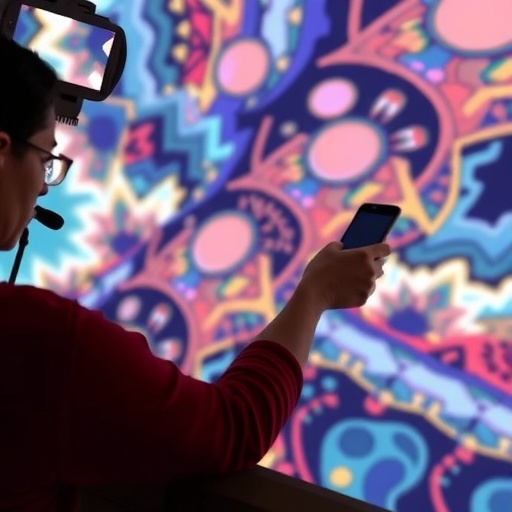Research has increasingly focused on understanding the complex relationship between vision and tactile perception, particularly emphasizing how varying levels and timings of visual experience shape our haptic spatial perceptions. A newly published study by Coelho et al. in Biological Sex Differences sheds light on these intricacies by exploring the experiences of early blind, late blind, and sighted individuals. Their findings reveal a striking interplay between visual experience and haptic sensitivity, suggesting profound implications for our understanding of sensory integration.
At the core of the study lies the concept of haptic perception, which refers to the ability to perceive and understand the properties of objects through touch. Traditionally considered a secondary sense, haptic perception has been demonstrated to play a pivotal role in our spatial awareness and interaction with the environment. The authors delve into how visual experiences—or lack thereof—shape the ways individuals interpret haptic stimuli, influencing their spatial representations and object recognition abilities.
The researchers employed a systematic approach to assess haptic perception among different groups—early blind individuals, who have never experienced vision, late blind individuals, who lost their sight later in life, and sighted individuals. This methodological design offered a unique opportunity to compare how visual history impacts tactile feedback and spatial awareness. Through a series of carefully calibrated stimuli and assessments, they measured aspects like sensitivity, spatial localization, and depth perception through touch.
Initial findings indicate that early blind individuals exhibit heightened sensory acuity in their haptic perception, suggesting that the brain adapts profoundly to compensate for the lack of visual input. These individuals demonstrate superior abilities in tasks requiring spatial awareness derived from touch. The brain appears to repurpose regions typically associated with visual processing to enhance tactile experiences, thus facilitating a more rounded understanding of their surroundings through non-visual means.
Conversely, late blind individuals showcased a more complex response. Having acquired some visual experience during their formative years, these participants displayed mixed results in their haptic abilities. Their performance suggested that visual memory still influenced their spatial processing, albeit to a lesser extent than sighted individuals. This highlights the nuanced effects of visual experience over time and raises questions about the retention of visual memory in the absence of sight.
Sighted individuals, as anticipated, performed well in tasks requiring haptic input but relied heavily on visual cues for spatial orientation and object identification. Their performance underscored the fundamental role of visual information in complementing haptic feedback, leading to quicker and more accurate responses. The findings provoke thought about the potential trade-offs in sensory processing, suggesting that reliance on one sense might diminish the sensitivity of others.
Furthermore, the study’s results emphasize the importance of integrative sensory experiences in our daily interactions. As our environments increasingly rely on technology and digital interfaces, understanding these sensory dynamics becomes crucial. The implications stretch beyond academic curiosity; they reach into practical applications, such as the development of assistive technologies, rehabilitation programs for the visually impaired, and even enhancements in virtual reality environments.
A particularly intriguing aspect of the study is the extended exploration of how emotional and psychological factors interplay with haptic and visual experiences. The researchers posited that feelings of safety, anxiety, and familiarity could affect how tactile stimuli are configured and perceived. Such a lens encourages additional investigation into how emotional states modulate our sensory perceptions, potentially opening avenues for therapeutic practices focusing on enhancing haptic interactions.
Interestingly, the study’s findings also contribute to discussions around the malleability of the brain’s sensory pathways. Neuroplasticity—the brain’s ability to reorganize itself by forming new neural connections—was a focal point. The results indicate that the lack of visual experience could lead to significant neural adaptations that enhance tactile perception, suggesting a resilience in the blind community’s adaptations to their environments.
Following the study’s publication, several experts in sensory processing have begun engaging with the findings, advocating for deeper interdisciplinary research that marries neuroscience, psychology, and even philosophy. Such collaborations could illuminate the broader implications of sensory integration, potentially reshaping our understanding of consciousness and perception.
As society moves forward in exploring sensory modalities, it becomes imperative to recognize the rich tapestry of human perception, influenced by a spectrum of experiences. This study serves as a compelling reminder that our senses do not operate in isolation; rather, they form a complex network that fundamentally shapes our reality and interaction with the world.
In summation, Coelho et al.’s pioneering research sheds vital light on how optical and tactile perceptions intertwine across different populations. Their exploration into the effects of visual history on haptic spatial perception not only enriches the conversation around sensory integration but also begs further inquiry into practical applications that benefit individuals with varying sensory experiences.
As we stride into a future that increasingly embraces multisensory experiences, the knowledge gleaned from this research lays a groundwork for innovations in how we approach technology, learning, and human interaction. Each insight represents a stepping stone toward understanding the profound complexities of human sensory processing, making this study an essential contribution to the growing field of sensory science.
In conclusion, the interdependencies between our senses underscore the notion that perception is not merely a passive reception of stimuli but an active engagement with our environment. As research unfolds, we invite continued dialogue to unravel the mysteries binding our sensory experiences, for within these complexities lies the essence of human understanding.
Subject of Research: The role of visual experience in haptic spatial perception among early blind, late blind, and sighted individuals.
Article Title: The role of visual experience in haptic spatial perception: evidence from early blind, late blind, and sighted individuals.
Article References:
Coelho, L.A., Ramirez, D.E.A., Basta, S. et al. The role of visual experience in haptic spatial perception: evidence from early blind, late blind, and sighted individuals. Biol Sex Differ 16, 64 (2025). https://doi.org/10.1186/s13293-025-00747-y.
Image Credits: AI Generated.
DOI: 10.1186/s13293-025-00747-y
Keywords: Haptic perception, visual experience, sensory integration, early blind, late blind, sighted individuals, neuroplasticity, emotional affect in sensory processing.




